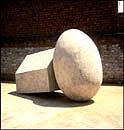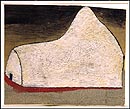N.N.
RIMZON India b.1957
House of heavens 1995
Resin, fibreglass, aluminium and marble dust
150 x 220 x 90cm
Purchased 1996.
Queensland Art Gallery Foundation
Collection: Queensland Art Gallery
Reproduced by permission
of the artist |

|
In 1992, the Barbri Mosque in
Ayodhya was destroyed by religious extremists. This action
heralded the beginning of a wave of religious violence in
contemporary India. The violence, particularly between Hindus
and Muslims, disrupted the harmony of democracy that Indians
had worked towards since their independence in 1947. It signalled
that the struggle for communal peace was far from over. N.N.
Rimzon has made many works that focus on the human dimension
of this upheaval.
In House of heavens,
Rimzon uses a personal set of motifs to comment on contemporary
life in India. Images that frequently appear include, the
egg - a symbol of fertility and the continuity of life; the
house - signifying personal and sacred protection; and the
sword - representing the intrusion of violence into many aspects
of personal and communal life.
|
|
N.N.
RIMZON India b.1957
White boat
1995
Charcoal, watercolour, synthetic polymer paint and
sand on paper
22 x 37cm
Purchased 1996.
Queensland Art Gallery Foundation
Collection: Queensland Art Gallery
Reproduced by permission of the artist
|
|
|
N.N.
RIMZON India b.1957
Blue shadow 1995
Charcoal, sand and blue pigment on paper
19 x 44cm
Purchased 1996.
Queensland Art Gallery Foundation
Collection: Queensland Art Gallery
Reproduced by permission of the artist
|
The use
of narrative composition has a long tradition in Indian art.
However, rather than telling a story, Rimzon uses his personal
language to construct works with a narrative suggestion. Through
the combination of various groups of images, he skilfully
uses the power of the metaphor to comment on important social
issues.
Although
figures appear to be absent in Rimzon's works, there is always
a suggestion of human involvement or consequence in his compositions.
For Rimzon, the image of an object such as a sword is not
only symbolic of violence but also representative of a more
personal threat - the threat to communal and family harmony.
 |
N.N.
Rimzon was born in the south of India in an area known
for its high level of literarcy and a radical, democratically
elected, Marxist Government. In the two years between
1975 and 1977, when Rimzon was at art college, India experienced
widespread political upheaval and activism. Rimzon and
his colleagues formed highly political artistic groups
and worked towards creating new forms of expression. Many,
including Rimzon, shunned painting - the dominant medium
in India - and experimented with new media. |
| N.N.
Rimzon |
In 1986 Rimzon exhibited an
installation at the 'Sixth Triennale International' in New
Delhi, at a time when installation was not really accepted
in Indian art circles. Rimzon continues to work in sculpture
and drawing. His drawings complement larger sculptures and
installations, but should also be seen as individual explorations
of the artist's overall concerns. The works in this exhibition
were shown at the Queensland Art Gallery in 1996 as part of
the 'Second Asia-Pacific Triennial of Contemporary Art'.
| Other
lines to follow for N.N. Rimzon |
'At the moment, though the
national creed is one of nonviolence, in thought and word
at least we seem to be drifting towards violence.'
The Words of Gandhi, sel. Richard
Attenborough, New Market Press, New York, 1982, p.91.
 |
N.N.
RIMZON India b.1957
When earth becomes red 1996
Wax on polystyrene,
red pigment
210 x 390 x 150cm
Collection: The artist
Reproduced by permission of the artist |
 |
N.N.
RIMZON India b.1957
Wax temple 1995
Charcoal,
wax, synthetic polymer paint, fabric and sand on paper
43 x 36cm
Purchased 1996.
Queensland Art Gallery Foundation
Collection: Queensland Art Gallery
Reproduced by permission of the artist |
'In nature there is fundamental
unity running through all the diversity we see about us. Religions
are given to mankind so as to accelerate the process of realisation
of fundamental unity'.
MK Gandhi website http://www.cbu.edu/Gandhi
'Non-violence is the greatest
force at the disposal of mankind. It is mightier than the
mightiest weapon of destruction devised by the ingenuity of
man.'
Ranka group webpage - India page
http://www.ranka.com/indiapgfr.html
|